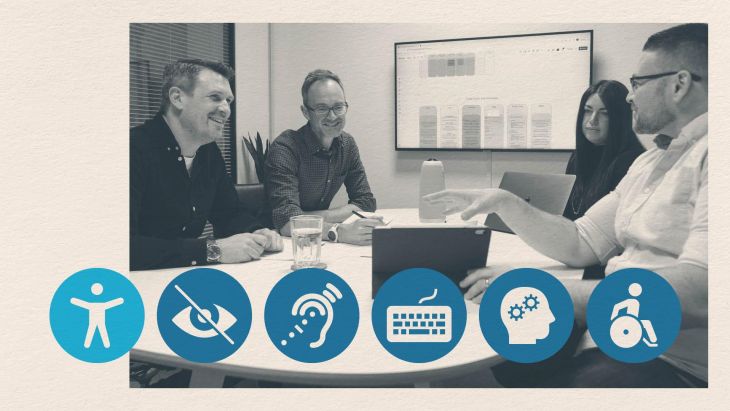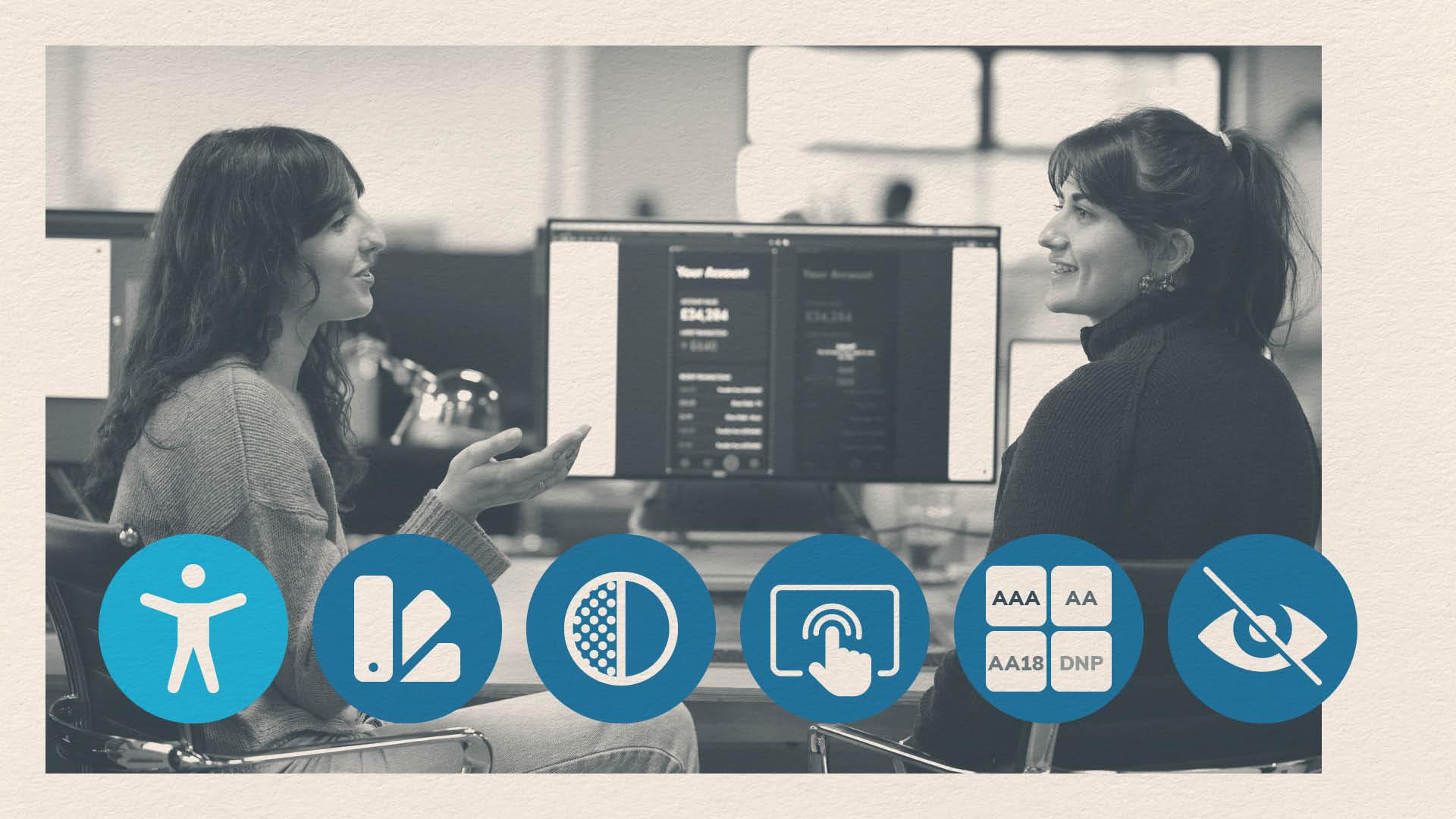What opportunities, challenges and tools exist for UX Designers optimising apps for accessibility?

What do we mean when discussing accessibility, what standards do we align to, and why should we and our clients care enough to invest in this?
Accessibility is a huge topic but, it isn’t always at the forefront of mobile app design and development. Here's how we can make react Native apps more accessible.
In this blog, part 1 of 4, we explore the opportunities, challenges and tools that UX Designers find when designing apps optimised for accessibility.
It turns out there’s a lot to say, so I have broken it down into two posts — the what and the how of accessibility. This first post dives into the former.
What is accessibility?
Great question, and one we think about across two categories — functional accessibility and relational, or environmental, accessibility.
Functional accessibility
Within the realm of product design, this is the main area covered when people talk about accessibility. It is the nuts and bolts around ensuring our app is available to everyone, whatever their accessibility needs. It does not relate to their experience outside of the app.
In short, it is how they interact with the app as a product, not how the app might help them in their environment.
Relational accessibility
This is where we have an opportunity to help people with accessibility needs outside of the app.
If we were designing an app for a supermarket chain, how might we consider the needs of someone with mobility needs? Perhaps we could highlight where the disabled parking bays are at each store. Or, even more powerfully, allow a customer to identify themself as having a mobility accessibility need in order to direct them to the disabled parking spaces at a store with wider aisles.
How about a parent with a child? Not typically someone we think about as having accessibility needs — but how might we help them find a store with parent and child parking and baby change facilities?
The opportunities here will depend on the client or product, and can bring real additional dividends to both, as we’ll see below in the Why do we care about Accessibility in UX Design? section.
What accessibility standards should a UX Designer be working to?
How do we know what is accessible and what is not? Within the realm of Functional Accessibility the Web Accessibility Initiative has defined the Web Content Accessibility Guidelines — more commonly known by the abbreviation WCAG.
Google’s Material Design have also created useful standards, which provide a very actionable resource for UX Designers and App Developers alike.
Web Content Accessibility Standards (WCAG)
This covers accessibility across the digital product spectrum, and is the global standard which all accessibility conformance is measured against. It is created for the Web, but we also use this as our benchmark when designing apps.
The standards the WCAG set down are extensive and wide-reaching. The criteria are all grouped under four main Accessibility Principles
Perceivable
Operable
Understandable
Robust
In addition, the WCAG define three grading standards — A, AA and AAA. More on this later…
Material Design Accessibility Guidelines
The Material Accessibility Guidelines are built upon three primary Principles:
Clear — Help users navigate by designing clear layouts with distinct calls to action.
Robust — Design your app to accommodate a variety of users.
Specific — Support assistive technologies specific to your platform, just as you support the input methods of touch, keyboard, and mouse.
Why do we care about Accessibility in UX Design?
Accessibility is a word that is often used, and most companies (rightly) have an accessibility statement on their website. Mostly, sadly, this is not much more than a box-ticking exercise as their app and/or website often don't meet the functional accessibility standard they claim to adhere to.
Why is this? As Lucia Liu states in her blog Accessibility in Design "Many companies see accessibility as a burden. We expect products to be usable and even desirable to users, but accessible? We can only hope."
How can we, as UX designers, help shift that position, and why should we or our clients care? There is investment required here, so what are the considerations?
1. Empathy
Surely, alongside a love for beautiful things, one of the primary natural skills a designer brings to the room is empathy. Here's why we think empathy is the most crucial creative skill.
We seek to understand a user's needs, iterate, test and refine. We care about our audiences, and our design work is proven to be stronger when we exemplify that through our work.
2. Reach
There are 1.3 billion people with a significant disability in the world today, representing 16% of the population, or 1 in 6 of us, according to The World Health Organisation. And, due to growth in non-communicable diseases and longer life, this number is growing all the time.
Imagine if your product was maximised to reach that extra 16% of the potential audience base. As Purple Tuesday states, "Disabled people are the most loyal customer". We are locking in loyalty by meeting their needs.
3. Opportunity
If the above wasn't enough incentive for your client, consider these two statistics sourced from Purple Tuesday:
"The spending power of disabled people and their households worldwide is currently estimated to be worth $8 trillion, increasing by 14% per annum. Only 10% of businesses have a targeted strategy for this huge market."
And, on the flip side, "70% of disabled people will NOT return to a business after receiving poor customer service"
What a pairing of statistics, and what an opportunity for any business to get behind.
4. Legal obligation
It is the law! There are two main Acts which directly inform the legal precedence around Accessibility conformance — the European Accessibility Act (EAA) and the Disability rights & Equality Act.
The EAA, set to take effect in June 2025, is a groundbreaking legislation aimed at ensuring all digital products, including websites and mobile applications, are accessible to everyone in the European Union. Read more about the European Accessibility Act here.
As outlined in the Disability rights & Equality Act 2010 there are six main types of disability discrimination. Transgression of those can lead to financial penalties and legal proceedings:
direct discrimination
indirect discrimination
failure to make reasonable adjustments
discrimination arising from disability
harassment
victimisation
At Brightec, our clients are usually fully on board in ensuring their products meet accessibility needs, but if you find yours are not there yet, points 2-4 above should help persuade them!
Discover our mobile app development projects.
How do I apply accessibility standards in UX design?
In our profession, it is most likely we'll have the opportunity to make a positive impact on type 3 above — failure to make reasonable adjustments. The question then to ask ourselves is: How might we be failing to make reasonable adjustments in our work output to help those with a disability? How would we even know?
We need to understand what is required, and know and be able to deploy tools to both help us design and test our products.
If we want to truly make our products accessible to all, we should be seeking to move from a post-design “does this product meet accessibility standards” approach to an “accessibility-first” approach.
Read Part 2 of this series; Tools for UX Designers to create accessible apps.
Looking for something else?
Search over 450 blog posts from our team
Want to hear more?
Subscribe to our monthly digest of blogs to stay in the loop and come with us on our journey to make things better!

